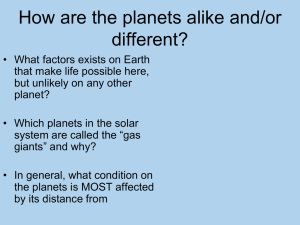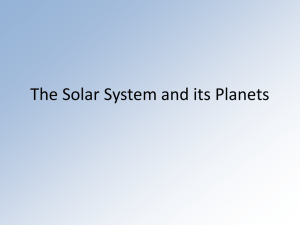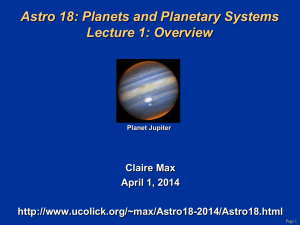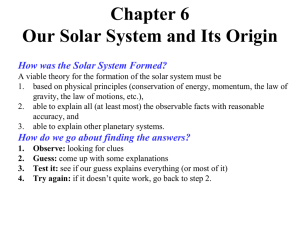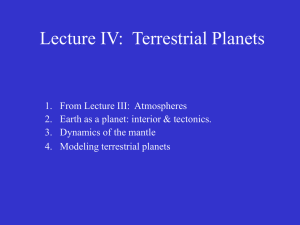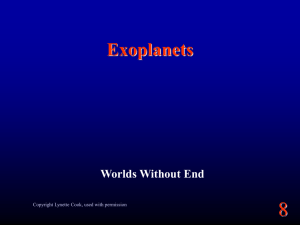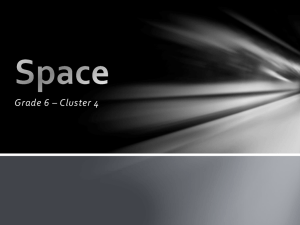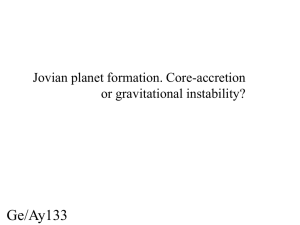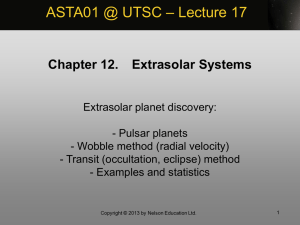Lecture9_2014_v2 - UCO/Lick Observatory
advertisement
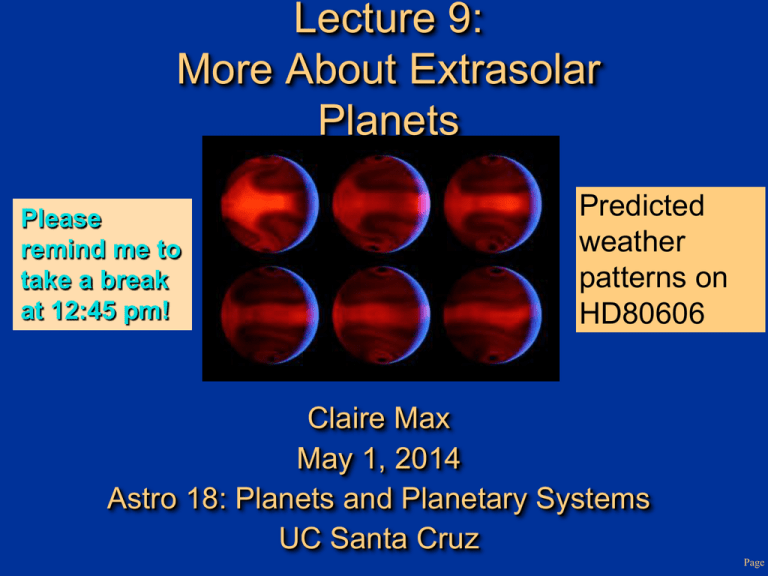
Lecture 9: More About Extrasolar Planets Please remind me to take a break at 12:45 pm! Predicted weather patterns on HD80606 Claire Max May 1, 2014 Astro 18: Planets and Planetary Systems UC Santa Cruz Page Outline of lecture • Formation of protoplanetary disks • Orbits and masses of exoplanets • Planet formation in the light of what we know about exoplanets today • Atmospheres of exoplanets • Future exoplanet detection plans Page Phases in the evolution of protplanetary disks: theory Credit: Jonathan Williams and Lucas Cieza Page Phases in the evolution of protplanetary disks: data 1 Myr Young protoplanetary disks: lots of dust and gas. Opaque. Planets and low-mass stars within disk can create features. 5 Myr Transitional disks: much less dust and gas. No longer opaque. Beta Pictoris disk 12-20 Myr Old disks: dust is replenished by collisions of rocky bodies. Protoplanetary disks have short lifetimes: a few million years • This means that giant planet formation must be very fast. • Giant planets must accumulate tens to hundreds of Earth masses of nebular gas, before gas is lost from the disk. Slide credit: Jonathan Fortney Core accretion: dust grains + pebbles stuck together to form larger bodies • Asteroid Itokawa in our own Solar System may be a close-up example • Called a “rubble pile” • Self gravity not large enough to make it round Unanticipated characteristics of extra-solar planets • Much higher eccentricity in most of their orbits • Much higher fraction of planets very close to their parent stars. • Many of these have masses comparable to Jupiter’s. • Many planets are “super-Jupiters” (up to 10 times more massive than Jupiter) Page Eccentric Orbits Page Eccentric Orbits • Orbits of some extrasolar planets are much more elongated (have a greater eccentricity) than those in our solar system. Eccentric Orbits • A significant number of the detected planets have orbits smaller than Jupiter’s. • But note that planets at greater distances are harder to detect with the Doppler and transit techniques. The shortest period exoplanets have orbits close to circular • Short period planets: –Very close to parent stars, very low eccentricity –Same process that moved planets close to star circularized their orbits Page Many extrasolar planets are very close to parent stars • Much of this is a selection effect – Radial velocity and transit methods more sensitive to planets close to parent stars • Nevertheless, there are many more close-in exoplanets than were expected • Our Solar System is very different (green points) Page Hot Jupiters: very close to parent stars Characteristics of Extra-Solar Planets: Mass Starting to see Neptunes and terrestrial planets Significant number of planets much more massive than Jupiter Page Characteristics of Extra-Solar Planets: Mass Jupiters and Super-Jupiters Neptunes Terrestrial planets Page Role of the “frost line” or “ice line” • Our Solar System has small rocky planets close to star, large gas giants further away – no experience of large massive planets close to sun in our Solar System • Theory of giant planet formation says they have to form outside “frost line” Page New evidence that the “ice line” is real in other solar systems • Disk around young star TW Hydra • Observed at brand new Atacama Large Millimeter Array (ALMA) by Qi and colleagues Page New evidence that the “ice line” is real in other solar systems • Disk around young star TW Hydra • Observed at brand new Atacama Large Millimeter Array (ALMA) by Qi and colleagues • Red dashed line shows position of “ice line” of CO Page How are giant extrasolar planets formed? • Theory for our Solar System: – Stellar wind from young Sun blew volatiles outwards – “Snowstorm” at 5 AU where water-ice solidified – Fast accretion of large icy planet (~10 MEarth) which then collected H/He atmosphere » Gas giants Jupiter, Saturn just outside “frost line” » Small rocky planets inside » Slowly accreting icy planets in outer system (Uranus, Neptune) • Extrasolar giant planets: – Do they form in situ? » looks impossible: too hot for ices, too little material for rock – Do they form outside frost line and migrate inwards? » planet forms in gas/dust disc around star » drag from remaining gas/dust causes it to spiral inwards » or scattering from other giant planets causes migration » why does it stop? Page This is the “paradigm shift” • Original theories of solar system formation developed when our own Solar System was the only one – Mostly circular orbits – Giant planets in outer solar system, terrestrial planets inside • New Solar Systems are (in general) not like ours • Needs a new theory • How to arrive at a new paradigm? – Mostly use computer simulations to develop ideas, test hypotheses, make predictions – Test predictions against observed young solar Page Theories for how giant planets got so close to their stars 1. Interactions between individual new planets and gaseous disk. “Migration” 2. After gas disk cleared away, several giant planets in outer parts of solar system were left – Three-body gravitational interactions between them – One giant planet got slung outwards, a second was slung inwards and got “captured” by the star in a close orbit – But why isn’t the close orbit very elliptical? • Why didn’t our own Jupiter migrate inwards close to Sun? Page Planetary Migration in a massive disk • A young planet’s motion can create waves in a planetforming disk. • Models show that matter in these waves can tug on a planet, causing its orbit to migrate inward. 1. Planet formation in gaseous disk • One planet in a gaseous disk • Accretion begins, gap starts to form • Planet can continue to accrete mass even after a “gap” in disk has formed • From computer simulation by Pawel Ciecielag Page Computer simulation by Armitage • Formation of planet and gap within a protostellar disk • Planet can continue to accrete mass even after a “gap” in disk has formed • As a result of the interaction with the disk, the planet moves in Page YouTube videos: planet migration • https://www.youtube.com/watch?v=ko52m9j JGTQ • https://www.youtube.com/watch?v=nwSNU3 -m0ew Hypothesis 2: Gravitational Encounters • Close gravitational encounters between two or three massive planets can eject one planet while flinging the other((s) into a highly elliptical orbit. • Multiple close encounters with smaller planetesimals can also cause inward migration. Orbital Resonances • Resonances between planets can also cause their orbits to become more elliptical. Thought Question What happens in a gravitational encounter that allows a planet’s orbit to move inward? A. It transfers energy and angular momentum to another object. B. The gravity of the other object forces the planet to move inward. C. It gains mass from the other object, causing its gravitational pull to become stronger. Thought Question What happens in a gravitational encounter that allows a planet’s orbit to move inward? A. It transfers energy and angular momentum to another object. B. The gravity of the other object forces the planet to move inward. C. It gains mass from the other object, causing its gravitational pull to become stronger. Hypothesis 2: Multi-Planet Interactions as Cause of Planetary Migration Simulation: start with 100 Planet “Embryos” Scatter, Collide, Stick, Accrete Gas After 21.5 Myr: Chaos After 30 Myr: Lone Close-in Jupiter in Eccentric Orbit. Page What have we learned? • Can we explain the surprising orbits of many extrasolar planets? –Original nebular theory cannot account for the existence of hot Jupiters. –Planetary migration or gravitational encounters may explain how Jupiter-like planets moved inward. • Can we explain large eccentricities of exoplanets? –Migration and encounters may play a larger role than previously thought. Parent stars of extrasolar planets • High in elements heavier than hydrogen and helium • Reasonable: planets form from dust, which is made of elements heavier than hydrogen and helium Pplanet ~ (NFe/ NH) 1.6 • Probability of finding a planet increases as heavy element content Page Gas giant planets prefer stars with high metallicity Smaller planets Gas giant planets Credit: Buchhave, Nature article Smaller planets seem to form around stars with a wider range of metallicity Atmospheres of exoplanets: How do we learn about them? • Transit method: subtract spectrum of star from spectrum of star plus planet, to see spectrum of planet alone • Direct imaging method: take spectrum of planet directly, since it is spatially separated from the parent star Transits and Eclipses • Transit: when a planet crosses in front of a star. • Eclipse: when star passes between us and the planet • No orbital tilt: accurate measurement of planet mass (planet wouldn’t transit at all if orbit were Seager & Deming, Annual Reviews of Astronomy & Astrophysics (September 2010) Credit: Jonathan Fortney, Sky and Telescope Magazine Credit: Jonathan Fortney, Sky and Telescope Magazine Credit: Jonathan Fortney, Sky and Telescope Magazine Credit: Jonathan Fortney, Sky and Telescope Magazine Water in the spectrum of planet Hat-p-1b Credit: Wakeford, 2013 Surface Temperature Map • Measuring the change in infrared brightness during an eclipse enables us to map a planet’s surface temperature. Beta Pictoris b spectrum, Gemini Planet Imager (direct imaging with adaptive optics) Model T=1600K log(g)=5 Massive planet Credit: GPI Team First Images of Exoplanets: HR 8799 Solar System Marois et al. 2008, Science Magazine Page Atmosphere of HR8799 planets Methane Clouds & CO Jupiter HR 8799 planets COOL RED BROWN DWARFS DWARF STARS Burgasser et al. 2009 white paper / after Lodders & Fegley 2006 Future ambitious space missions to detect Earth-like planets PLATO: European Space Agency TESS: NASA WFIRST: NASA Page Ambitious space mission: Occultor missions giant starshade Remi Soummer Giant starshade freefloating in space James Webb Space Telescope (2018 launch) Jeremy Kasdin
